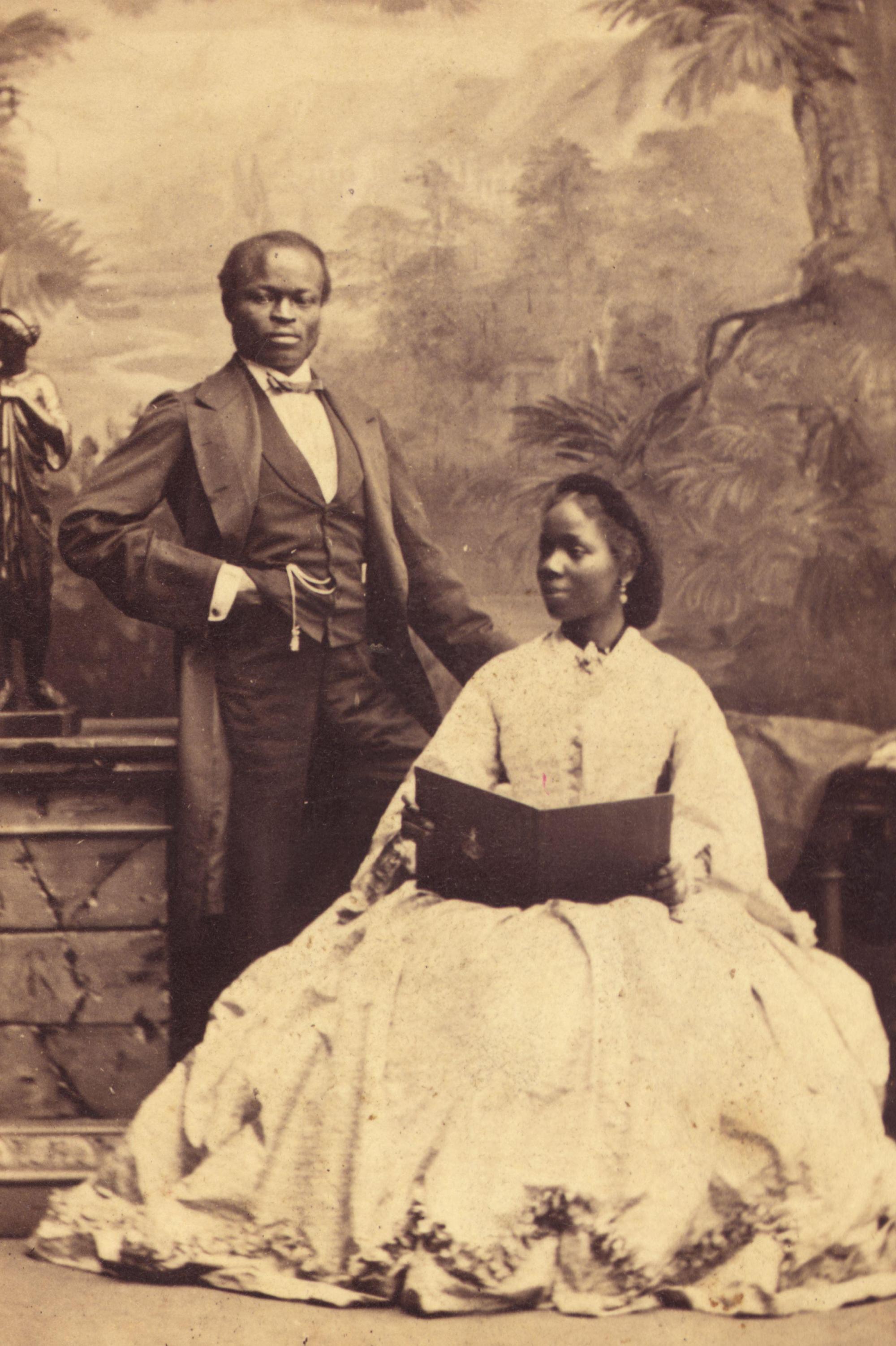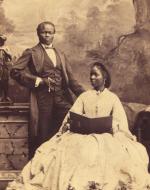Created by Bethany Kujawinski on Fri, 10/23/2020 - 11:20
Description:
There have been many strong, independent rulers who identified as women of color throughout history, however, a lot of their stories have been lost to time. Despite this, one tale that has not been forgotten is that of Omoba Aina, otherwise known as Sarah Forbes Bonetta. While she may not be as well-known as Queen Victoria or Queen Elizabeth, her story is just as important and interesting. In 1843, Sarah was born into the Egbado clan of the Yoruba people (Braimah). She was the young princess of the Egbado clan, which resided in the African country that is now known as Nigeria. One night, when she was only four years old, her village was attacked by a slave trading ruler, King Gezo from Dahomey (Myers 13). King Gezo and his men burned her village to the ground, kidnapped the people of her clan to sell them into slavery, and then killed her parents right in front of her (Myers 14). Those who were not taken were murdered, but Sarah was not sold into slavery or killed. Those of royalty in the Egbado clan wore specific markings on their faces to distinguish their status above the others, so when King Gezo and his men noticed that Sarah had the markings of a princess on her face they decided to take her with them back to Dahomey (Myers 14). However, while Sarah might have escaped death in her village, she was not yet free from its grasp.
Upon return to King Gezo’s village, Sarah was placed into a sacrificial ceremony called “Ek-onee-noo-ah-toh” or “the watering of the graves” where she would be beheaded, and her blood would fall upon the graves of Dahomey ancestors (Forbes). On the same day that this sacrificial ceremony was supposed to take place, though, a young British Commander by the name of Frederick Forbes was in the village trying to persuade King Gezo to stop slave trading and raiding villages (Braimah). He took notice of the little girl and made great efforts to save her from this untimely death. Frederick bargained for her life, saying that, “She would be a present from the King of the Blacks to the Queen of the Whites.” (Braimah). After saving her from being sacrificed, he took her in as one of his own children. He understood that, “she faced great personal tragedy, and must have suffered great trauma” (Bressey), which is why he felt the desire to look after her. For a year, Sarah and Fredrick remained in West Africa where he taught her how to speak English, baptized her, and gave her the name she is now known as: Sarah Forbes Bonetta (Braimah). He chose Forbes so he could give her his own surname, and Bonetta was the name of his ship that he had sailed on when he first found her at Dahomey. Frederick is quoted saying about Sarah that, “She is a perfect genius; she now speaks English well, and [has] great talent for music… She is far in advance of any white child of her age in aptness of learning, and strength of mind and affection…” (Braimah).
On November 5th, 1850, Fredrick and Sarah arrived in England and Sarah was taken to the Windsor Castle to meet Queen Victoria (Braimah). At this first meeting, Sarah informed Queen Victoria about her life and how she had been taken as a prisoner by King Gezo. Sarah, along with several other prisoners, were placed into crowded cages where they would only be released if they were going to be sacrificed (Forbes). Once their gathering came to a close, Queen Victoria wrote to herself that, “Capt. Forbes saved her life, by asking for her as a present. She was brought into the Corridor. She is seven years old, sharp & intelligent, & speaks English. She was dressed as any other girl.” (Forbes). The Queen was so impressed by Sarah’s intelligence and moved by Sarah’s story that she decided to make Sarah her goddaughter. She covered all of her financial expenses, and later that year when Commander Frederick Forbes passed away, the Queen made sure that Sarah had a place to go (Forbes).
For the rest of her life, she spent her time moving between the Windsor Castle and a Church Missionary School in the African country of Sierra Leone where she completed most of her schooling. She became fluent in French and was taught the mannerisms of how to be a lady in upper class English Society (Forbes). She remained close with the Queen throughout her life and even attended two of Queen Victoria’s daughters’ royal weddings (Braimah). Then, at the age of nineteen, Queen Victoria gave Sarah permission to marry Captain James Pinson Labulo Davies of Sierra Leone in August of 1862 (“Sara Forbes Bonetta.”). After they were married, they moved back to Africa and Sarah decided to teach in a school while her husband worked in business (Forbes). Together, they had three children, two girls and one boy. The first being Victoria Davies, named after Queen Victoria, and this daughter also became a godchild of Queen Victoria (Forbes). Sarah and her husband remained in Africa until Sarah was officially diagnosed with tuberculosis. Upon this unfortunate discovery, Sarah moved to Funchal on the island of Madeira with hopes of recovery (Forbes). She died on August 15th, 1880 at the age of 37 and is buried in in the British Cemetery of Funchal (Braimah).
Works Cited:
Braimah, Ayodale. “Sarah Forbes Bonetta (1843-1880).” Blackpast, 30 Jan. 2020, www.blackpast.org/global-african-history/bonetta-sarah-forbes-1843-1880/.
Brennan, Summer. “A Natural History of the Wedding Dress.” JSTOR Daily, 27 Sept. 2017, daily.jstor.org/a-natural-history-of-the-wedding-dress/.
Bressey, Caroline. “Of Africa's Brightest Ornaments: a Short Biography of Sarah Forbes Bonetta.” Taylor & Francis, 21 Apr. 2010, www.tandfonline.com/doi/abs/10.1080/1464936000074675.
“Camille Silvy (French, 1834 - 1910) (Getty Museum).” The J. Paul Getty in Los Angeles, www.getty.edu/art/collection/artists/1532/camille-silvy-french-1834-1910/.
“Camille Silvy.” Wikipedia, Wikimedia Foundation, 28 Sept. 2020, en.wikipedia.org/wiki/Camille_Silvy.
Forbes, Bart. “Sarah Forbes Bonetta.” Clan Forbes Society, 7 Aug. 2020, www.clan-forbes.org/post/sarah-forbes-bonetta.
Myers, Walter Dean. At Her Majesty's Request: an African Princess in Victorian England. Scholastic Press, 1999.
Olanrewaju, Adenike. “The Fabric of Nigerian Weddings.” The New York Times, The New York Times, 20 Aug. 2019, www.nytimes.com/2019/08/20/fashion/weddings/the-fabric-ofnigerian-weddin....
“Sara Forbes Bonetta.” Wikiwand, 2020, www.wikiwand.com/en/Sara_Forbes_Bonetta.
“Sarah Forbes Bonetta (Sarah Davies).” National Portrait Gallery, 2014, www.npg.org.uk/collections/search/portrait/mw66053/Sarah-Forbes-Bonetta-....
“Victorian Photographic Techniques.” National Museums Scotland, www.nms.ac.uk/explore-our-collections/stories/science-and-technology/vic....



